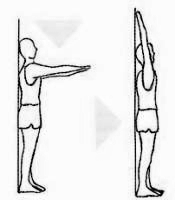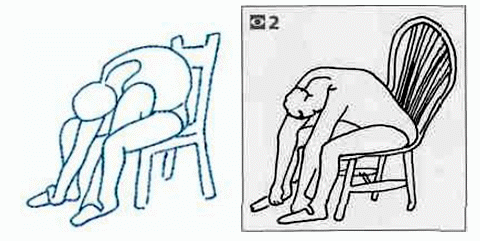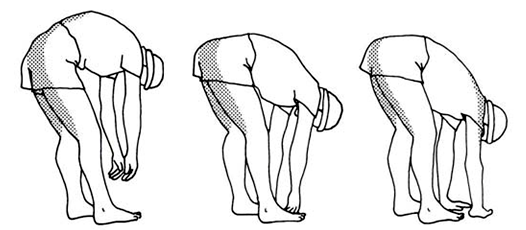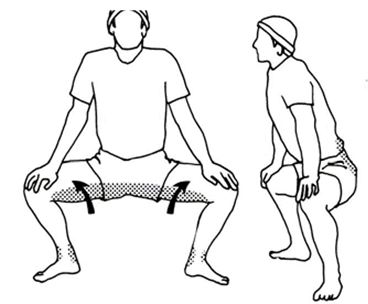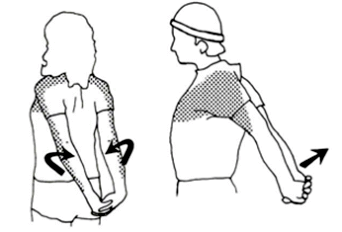Prevention by sportive activity
 As an orthopedic surgeon my main focus is to prevent locomotor system diseases, since orthopaedic prevention often is neglected in comparison to the prevention of cancer. This is, whereas orthopaedic diseases appear more frequently.
As an orthopedic surgeon my main focus is to prevent locomotor system diseases, since orthopaedic prevention often is neglected in comparison to the prevention of cancer. This is, whereas orthopaedic diseases appear more frequently.
One example: a 43-year-old patient complains of painful motion restriction of his both hip joints. By this his normal life is considerably complicated. If he had undergone a preventive check 5 years ago , the changes on both of his hip joints by being painfree at this time, could have been detected early. The damage could have been reduced, if not even been avoided. Now a hip replacement is necessary. Therefore a regular orthopaedic prevention with checkup of the locomotor system as well as an individually adjusted sportive activity, preferably under supervision of a certified coach is extremely important. The sportive activities depends on different basic conditions: besides the age and the anatomic conditions of each specific body region posture and motion are decisive in particular for an efficient sportive exercise. For this biomechanics, muscular balance, and in case postural disorders have to be taken into account. An aimed and individually adjusted training structure avoids disturbances in terms of dysbalances and results in a coordinated and specific motion sequence. Orthopaedic prevention is at least as important as cancer prevention. Avoid this risk by doing prevention, before severe and besides unnecessary damage occurs. Therefore prior to every sportive activity a stretching (=extension exercises) of the participating joints and the spine is mandatory, in order to avoid inappopriate stresses or chronic damages. Essential exercices, which I show my patients in my daily work, I want to present to you briefly. You can perform these exercises on your own at home, at work or prior to each of your sportive activities:
Streching of your chest and belly
Take a supine position, extend your arms and hands as well as your legs and feet in longitudinal direction totally (keeping the back of your hands flatly on the floor), avoiding a hollow back (control by the flat hand of another person in your waistline). Keep this position for 1 minute.
Standing with your back towards the wall. After arch-shaped lifting of your arms over your head extend your arms and legs in the longitudinal direction totally (keeping the back of your hands flatly on the wall). Your heels, knees, buttocks, elbows and shoulders also remain on the wall, avoiding a hollow back (control by the flat hand of another person in your waistline). Keep this position for 1 minute. Then lowering your arms on the side of your body down to your legs.
Stretching by rotation of your spine lying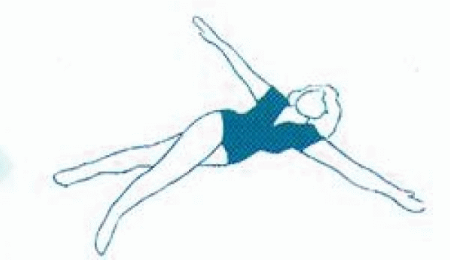
Take a supine position, extend your arms on the floor in a 90° angle sidewards („like an eagle”), then turn the palm your right hand downwards. („closed hand“) and the palm of your left hand upwards („open hand“), then maximal turn of your head to the left towards your open hand („when crossing a road, you look first, if it is free“), afterwards crossing your bent right leg over your extended left leg at the level of your left knee, the bent right knee falls to the left, your pelvis needs to be turned slightley to your left side, each of your shoulders and arms remain on the floor in the turned starting position („your right hand claws firmly to the floor“). Now you extend your right leg simply in your knee, resulting in a „shearing position“ of both legs with an angle less than 45 degrees. Both ankles are kept in a 90 degrees position. In the ideal case an assisting person by cautious holding this stretching postion with the flat hand on your shoulder and above your knee joint, to optimize the stretching effect. Keep this position 1 minute. Afterwards you change sides. Here you keep this position 1 minute, too.
Keep in your mind for practising : Arms Head Legs AHL
Stretching of your chest and belly
You take an upright position on a chair, keep your feet shoulder-width apart vertically in front , then stemming your hands in your hips, so that your little fingers are positioned front-inwards and both thumbs outside-backward. By bending your body forward you glide with your hands embracing on both sides of your thighs, knees and then lower legs downwards, until you reach the upper margin of your external ankle with your thumbs.. Thereby your little fingers are positioned at the internal ankle and your extended elbows at the internal side of your knees. Your extend your back completely and keep your head and neck downwards but straight in a longitudinal position. Like on a serving tray a vase should stand still on a straight back without any problems. Keep this position for 1 minute.
Stretching of your legs
It will be easier for you to keep this stretching position, if you distribute your body weight on your arms and legs. If you cannot support the palms of your hands on the floor when your knees are angled, then you can help yourself by using a step, a prominence or a staple of books, to support yourself with your hands.
For stretching of your calf, you place yourself in front of a solid support and lean against it with your lower arms, keeping your head on your hands. Bend one of your legs and place its foot on the floor in front of you, extending your other leg backwards. Move your hip slowly ahead and keep your lower back straight. The heel of your extended leg should touch down totally. Your toes point ahead or are rotated slightly inwards. Keep this extension for 30 seconds. Don’t rebound, train both sides..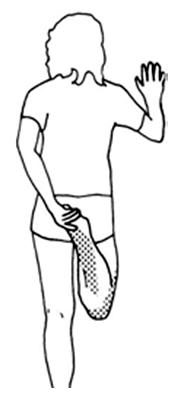
For stretching your knee-extensors and knee, you take the tip of your right foot with your left hand and pull your heel cautiously to your buttocks. You knee is bent in a natural angle, if you hold your foot with your opposite hand. Hold the extension for 30 seconds on each leg.
Stand in a knee-bent position, which contracts your quadrizeps-muscle and relaxes the tendons of your knee-flexors. Keep this position for 30 seconds. Your frontal leg-quadrizeps should now feel tight and contracted, whereas your backward leg-tendons feel soft and relaxed.
In an upright-position, you place your hands slightly on the inner side of your thighs, just above your knees. Your feet should be standing at least shoulder-width apart from each other. Lower your hips slowly whereas you push your thighs smoothly outward.until you feel a mild extension in each of your inguinal areas. Keep this position for 15 seconds. You must not lower your hips below your knees.
Fold your hands over your head. Turn the palms of your hands upwards, extend your arms slightly back and up. Feel the extension in your arms, shoulders and your upper back. Keep this extension for 15 seconds. Do not stop breathing. This stretching exercise can be performed anywhere and at any time.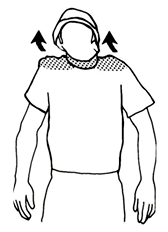
Circling your shoulders. Raise your shoulders up to your ears, until you feel a slight tension in your neck. Maintain your feeling of tension for 3-5 seconds, relax your shoulders again in their normal position. repeat this 2 or 3 times. This exercise is good when the first signs of muscle tenseness in your shoulders and your neck.
Lift your extended arms behind your back, until you feel an extensionin your arms, your shoulders or your chest. Keep a slight extension for 5 -15 seconds. This exercise is worthwhile, when you realize your shoulders hanging forward. Keep your chest raised up and your chin backwards.
This is a simple stretching exercise for your upper arms and your shoulders. With your arms over your head you grab the elbow of your arm with your opposite hand. Raise your elbow cautiously behind your head in order to evoke the extension. Do this exercise slowly, and keep your extension for 15 seconds. Do not try, to relax by using force. Stretch both sides. This is a good method to start relaxing your arms and shoulders. You can do this exercise when walking.
The exercises
Your choice of the presented exercises above depends on the type of sportive activity you want to do. However, with these exercies you can prepare almost all forms of sport effectively what concerns stretching. By this you can perform prevention in order to avoid chronic damage.




